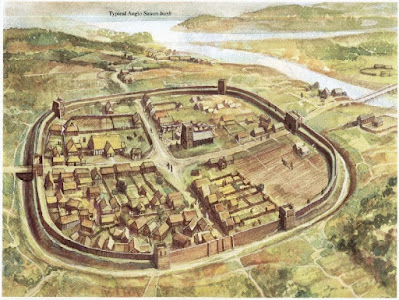In response to Viking raiding up the Severn, Æthelred and Æthelflæd, the Lord and Lady of the Mercians, built a series of fortified settlements, known as burhs, to control he movement of the Norse raiding parties. The Vikings would come up the Severn again, this time in 910, resulting in the Battle of Tettenhall. The battle was a resounding victory for the Anglo-Saxons.
 |
| Æthelflæd's burhs |
The Mercian Register, from the Anglo Saxon Chronicle 'C' version, records a series of burhs constructed, in all likelihood in response to Tettenhall, mainly by Æthelflæd alone after Æthelred's death in 911, which included the restoration of Chester (907), Bremesburh (910), Scergeat and Bridgnorth (912), Tamworth and Stafford (913), Eddisbury and Warwick (914), Weardbyrig, Chirbury and Runcorn (915):
912 - "Here, on the eve of The Invention of the Holy Cross, Æthelflæd, the Lady of the Mercians, came to Scergeat and built the burh there, and in the same year that at Brycge." - The Mercian Register (The Annals of Aethelflaed)
The entry in the Mercian Register appears to be the earliest mention of the burh at Scergeat and all later sources are likley to have derived from it. It was clearly a site known to the Mercians and possibly the name changed shortly after construction. We are informed that the name "scergeat" in Old English means something like "boundary gap" or "boundary route" indicating that the burh was sited near an access point in the Mercian frontier.
David Horovitz (Æthelflæd: Lady of the Mercians, 2017, pp.148-49) writes that in "scergeat" the element "scer" can be found in variant forms, scear, scier, scir, suggesting the Old English 'scir' for 'shire' = 'an administrative district, a county; bright, clear'. Other possible interpretations include Old English 'scearu', 'scaru' = 'a share, a shearing, district boundary', and 'something which cuts off'.
The second element, Old English "geat" = 'a gate, a gap, an opening, a ravine or pass', according to Horovitz, often used for physical gaps in earthworks or walls, or entrances to parks or enclosures with a similar meaning to Old English 'sceard', 'scard', 'scerde' = 'an incision, a notch, notched, a cleft, a gap; gashed, mutilated'.
There could be many sites identified as gaps or access points in the boundary of Aethelflaed's Mercia; perhaps a natural pass through the uplands, or a break in a linear earthwork. For example, Jane Wolfe (Æthelflæd; Royal Lady, War Lady, 2001) suggested that the location of the burh may have been constructed to defend the gap between Offa's Dyke and Wat's Dyke, proposing the Iron Age hillfort at Old Oswestry as a possibility.
 |
| A typical Anglo Saxon burh |
When the Lady of the Mercians constructed two burhs in the same year it is likely that they were in close vicinity, such as in 913 at Stafford and Tamworth, in this case just 30 miles apart. From this it is reasonable to speculate that Scergeat was near Brycge.
The identification of Brycge, "the Bridge", is generally accepted as Bridgnorth a crossing point on the river Severn in Shropshire.
Can we expect Scergeat to be somewhere along the Severn, within perhaps 30 miles of Brycge, where a natural or manmade feature provides access into Mercia?
Recognising the strategic importance of the site, in the 12th century the Normans constructed a motte and bailey on the hill overlooking the crossing point, the site thought to mark the site of Aethelflaed's burh, but no trace of the Anglo-Saxon construction has yet been found there. With this doubt cast on the confidence of Bridgnorth as the site of the burh at Brycge alternatives have been sought.
In 895 a Viking army camped at "Cwatbrycge" while raiding along the river Severn. This has been identified as the village of Quatford, barely a couple of miles south of Bridgnorth. If Quatford is correctly identified as the burh at 'Brycge' then it is likely that 'Scergeat' is within 30 miles distance.
Note:
Posted in response to a recent email asking about the interpretation of Scergeat as "boundary gap". The sender thinks he may have the answer to the location of the burh of Scergeat. We await his response.
* * *

No comments:
Post a Comment
Note: only a member of this blog may post a comment.